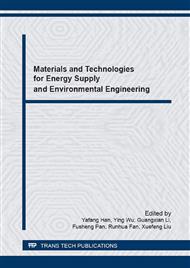[1]
F. Gao, Research on life cycle assessment and the application in China magnesium industry, Beijing, Beijing university of technology, (2008).
Google Scholar
[2]
S.P. Cui, N. Luo and Z.H. Wang, Study on equivalent of non-renewable resources depletion for building materials life-cycle-assessment, China building materials science and technology, 4(2009)1-5.
Google Scholar
[3]
H Baumann, T Ekvall, Rydberg T, et al, Aggregation and Operative Units for Impact Analysis in Environmental Life Cycle Assessment (LCA) of Products, SETAC Workshop on LCA of Leiden University, (1991)87-94.
Google Scholar
[4]
L. van Oers, A. de Koning,J. B. Guinee, et al, Abiotic resource depletion in LCA, Institute of Environmental Sciences-Leiden University, (2002).
Google Scholar
[5]
M Goedkoop and R Spriensma, The Eco-indicator 99: A Damage Oriented Method for Life Cycle Impact Assessment Methodology Report, PRé Consultants, Amersfoort, (2001).
Google Scholar
[6]
F Göran and Ö Per, Exergies of natural resources in life-cycle assessment and other applications, Energy, 9(1997)923-931.
DOI: 10.1016/s0360-5442(97)00022-4
Google Scholar
[7]
L Connelly and C P Koshland, Exergy and industrial ecology-Part 1: An exergy-based definition of consumption and a thermodynamic interpretation of ecosystem evolution, Exergy, 3(2001)146-165.
DOI: 10.1016/s1164-0235(01)00021-8
Google Scholar
[8]
L Connelly and C P Koshland, Exergy and industrial ecology-Part 2: A non-dimensional analysis of means to reduce resource depletion. Exergy, an International Journal, 4(2001) 234-255.
DOI: 10.1016/s1164-0235(01)00033-4
Google Scholar
[9]
S.B. Wang, R.S. Wang and Q.H. Wu, A new approach to calculate resource depletion potential and its equivalency factors in life cycle assessment, Journal of Fudan university, 5(2001)553-557.
Google Scholar
[10]
J.Y. Yan and G.J. Zhao, Modeling reasonable consumption of mineral resources based on regional development, Resources Science, 4(2006)151-158.
Google Scholar
[11]
J.B. Guinee, R. Heijungs, A proposal for the definition of resource equivalency factors for use in product life cycle assessment, Environmental Toxicology and Chemistry, 14(1995) 917-925.
DOI: 10.1002/etc.5620140525
Google Scholar
[12]
S.B. Wang, W.J. Zhang, T.X. Yang, G. Zhao and Z.Q. Fan, The characterization factors of abiotic resource depletion and its changes with time in LCA, Journal of Fudan University(Natural Science), 51(2012) 125-130.
Google Scholar
[13]
K. Strauss, A.C. Brent and S. Hietkamp, Characterization and normalization factors for life cycle impact assessment mined abiotic resources categories in South Africa, International Journal of Life Cycle Assessment, 11(2009) 162-171.
DOI: 10.1065/lca2004.10.183
Google Scholar
[14]
H. Ping, H.T. Wang, Y.G. Zhu and D. Weng, Chinese scarcity factors of resouces/energy and their application in life cycle assessment, Journal of Natural Resources, 27(2012) 1572-1579.
Google Scholar
[15]
Editorial Board of China Mining Yearbook, China Mining Yearbook 2004-2012 (in Chinese), Beijing: Di Zhen Press.
Google Scholar
[16]
Editorial Board of the Yearbook of Nonferrous Metals Industry of China, The yearbook of Nonferrous Metals Industry of China 2013 (in Chinese), Beijing: The Yearbook of Nonferrous Metals Industry of China Press, (2013).
DOI: 10.1016/s1003-6326(13)62800-9
Google Scholar
[17]
Information on http: /www. cinic. org. cn/site951/hangye/hyzt/2014-03-24/727915. shtml.
Google Scholar


